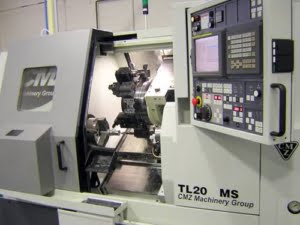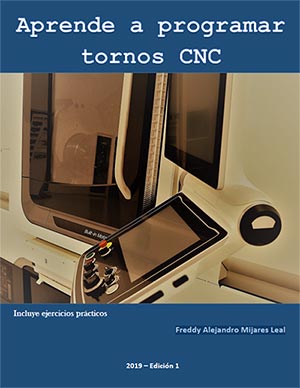Learn to program CNC
 In the modern world, it is no longer worth comparing a conventional lathe with a computer-controlled one; even talking about their concept seems a thing of the past. Numerical control lathes or turning centers offer us very great advantages over their predecessors, some of these advantages are:
In the modern world, it is no longer worth comparing a conventional lathe with a computer-controlled one; even talking about their concept seems a thing of the past. Numerical control lathes or turning centers offer us very great advantages over their predecessors, some of these advantages are:
– Repetitiveness
– Precision
– Machining complexity
– High production
And this is just to name a few because the list goes on and on.
In Latin America we have a huge problem in terms of professionals adequately prepared to program CNC machines. The vast majority have learned empirically working in small workshops, others have been lucky enough to be in companies that send them abroad to take more specific and/or specialized courses, and finally, and I am sure this must represent less than 5%, they have learned at university or some institution that provides this type of education.
This book that we share with you is aimed at all those people who want to learn how to program numerical control machines in a practical, simple way, following an orderly methodology, trying not to “get our fingers wet, lift them and see which way the wind blows” to make decisions.
The programmer must be trained to do mathematical calculations, reading and interpreting blueprints, types of materials, selection of cutting tools, etc.
Although it is a useful guide to learn how to program numerically controlled lathes, it does not represent the solution to all the problems you may encounter. Practice, training and continuous work are the best ways to become better at what we do. I hope you enjoy the book very much.
CNC lathes
These are machines used to remove material, by removing chips, from basically cylindrical or tube-shaped pieces. The principle consists of holding the piece to be machined in the spindle, it starts to turn and we pass a cutting tool over the surface of the piece until it has the desired shape.
They can also be called turning centers, although this is not very common. The main parts of a lathe are:
– Spindle: mechanism that holds the piece to be turned.
– Turret: Device where the cutting tools are placed.
– Tailstock: A device that serves as a support for the workpieces. It holds the workpiece on the opposite side of the spindle (aligned with it) and is used for workpieces that are long in length (generally when they exceed the diameter-length ratio of 3:1). Example: If a workpiece has a diameter of 25mm and its length is 100mm, it requires a tailstock.
Lathes can be divided into several types, depending on the spindle orientation (horizontal and vertical), bed design (inclined or straight) and the number of axes (milling lathe, multitasking, etc.).
We leave you the link to download the Ebook “Learn to program CNC lathes” by the author: Freddy Alejandro Mijares Leal
CNC Syllabus:
1. CNC lathes
2. Axes on a CNC lathe
3. Zero work and machine
4. Machinability
5. Calculation of cutting conditions
6. Coordinate system
7. Planning a program
8. G-Codes
9. M codes
10. G00 Fast Movement
11. G01 controlled linear motion
12. Controlled circular motion G02 and G03
13. Roughing cycle – displacement G71
14. Facing cycle – G72 facing
15. Irregular contour roughing cycle – G73 displacement
16. G41, G42 and G40 tip radius compensation
17. G70 Contour Finishing Cycle
18. Drilling cycles G81, G83, G85
19. G84 and G74 tapping cycles
20. Threading cycle G76
21. G75 grooving and parting cycles
22. G52 Coordinate transfer
23. Documentation of a CNC program
24. CNC Control
25. Exercises



